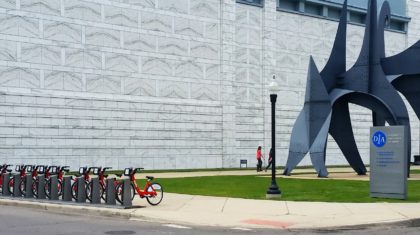
by Jeff Knowles, Associate Planner, Alta Planning + Design
Almost halfway between San Francisco and Los Angeles sits the small town of Coalinga (population 17,000). In many ways Coalinga is a typical Central Valley agricultural community — residents draw their livelihoods from nearby ranches, farms, and oil fields. Established as a coal refueling station for steam locomotives in the 19th Century, the town’s ordered street pattern is legacy of its relationship with the railroad. A dense grid network means that the majority of residents can get across town in a short five minute bicycle ride or ten minute walk, however, most residents opt to get around the town’s four square miles by driving. Most children are bused to school or driven by parents despite ample sidewalks and short travel distances. Recognizing the opportunity to improve its walking and bicycling environment, the City hired Alta in 2015 to lead the development of the community’s first Active Transportation Plan.
Early attempts at engaging the community in the planning process included organizing a week’s worth community outreach activities — bike and walking tours, school audits, and a community workshop. Despite these efforts, attendance at our events was disappointingly low. Dead set on revamping the community engagement process this past fall, the Alta team started thinking how to engage people in their daily lives. An intervention near Coalinga’s schools quickly emerged as an easy way to intercept the greatest number of residents, especially some of the city’s most vulnerable. Coalinga’s schools are located adjacent to one another in a school complex, which lent itself to planning a centrally located set of activities.
By aligning with the Coalinga Unified School District, teachers, parents, and multiple City departments, Alta organized a massive outreach blitz aimed at focusing attention on creating Safe Routes to School — a centerpiece of the Active Transportation Plan. The outreach strategy involved delivering three activities over the course of 24 hours:
- Walk to School Day — a community program to encourage parents and students to try walking to school instead of driving or taking the bus
- Tactical Urbanism — a series of temporary “pop-up” crosswalks and curb extensions to demonstrate potential infrastructure improvements
- Community Workshop — an opportunity to share information about the plan and gather feedback from the public on the day’s activities
Alta worked especially hard to increase publicity in advance of the event. We worked with the PTA to design four “walking school buses” where parent volunteers would lead kids to school on foot from designated drop-off points, picking up more kids along the route. Parents helped spread the word by advertising on social media. The City placed ads on their electronic boards around town. The District distributed flyers for every student to take home. Perhaps the most effective publicity was actually a very pleasant surprise — the District made two rounds of robocalls to all parents and guardians encourage them to participate in Walk to School Day with their child.

The preparation for the demonstration infrastructure was a bit more challenging. High-visibility crosswalks were constructed in advance using rolls of roofing paper and yellow house paint. Spray marking chalk, vertical delineators, and borrowed hay bales from West Hills College’s educational farm were assembled to simulate curb extensions. At some crosswalks, we used the spray marking chalk to stencil in advance yield markings (shark’s teeth) to draw more attention to these temporary crosswalks.
The community workshop was organized at one of the school’s multi-purpose rooms, with food, kids activities, and Spanish interpretation advertised in advance (over one-third of Coalinga’s residents speak Spanish at home). Residents learned about the workshop by reading bilingual flyers posted around town, notices on the electronic billboards, and large posters installed at each of the pop-up crosswalks.

The day resulted in over 200 students walking to school; one child was overheard asking their parents if they could walk every day. The success of the event has sparked interest in organizing walking school buses on a regular basis. Parents also appreciated seeing how enhanced crosswalks and curb extensions promoted a less chaotic and safer drop-off and pick-up experience. Throughout the day the City was able to evaluate the placement of curb extensions and their impact on calming traffic. The day was capped off with the School District Superintendent, Police Lieutenant, Public Works Director, and a member of City Council joining two dozen residents at the Community Workshop.

Following this intense, but highly productive few days, our team is now incorporating the input we gathered to refine recommendations and prepare a public draft plan that should be available in December 2016.
To learn more, visit: http://walkbikecoalinga.org


